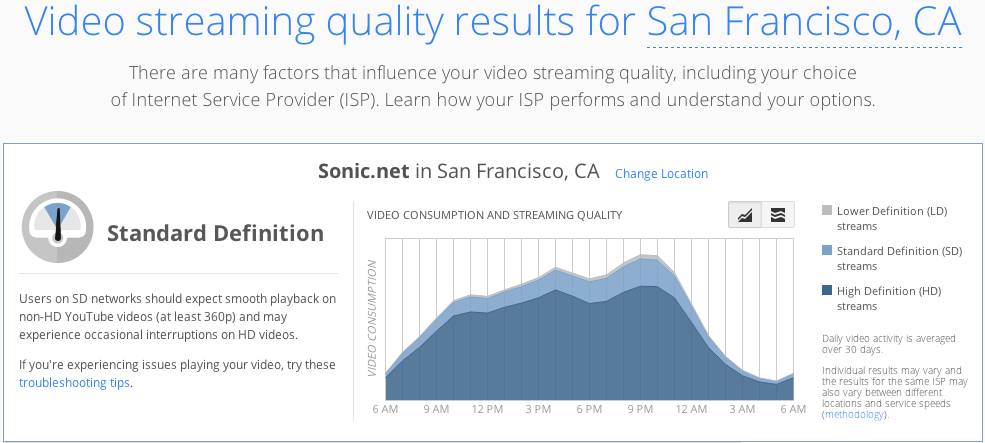Over the past six months or so, we’ve been hearing a lot more people saying that their YouTube videos are stalling just a few seconds after the stream starts. It’s happened at my desk, and it’s a bad experience.
YouTube probably isn’t to blame. More than likely, it’s a slow broadband connection courtesy of your friendly Internet Service Provider (ISP).
Internet companies like Google and Netflix are completely dependent on ISPs to get their services down the broadband pipe to the user. No surprise, then, that Google is starting to assign quality ratings to ISP services. The scoring system might deflect some consumer ire off YouTube and point it squarely at the real culprit, the ISP.
Google came out with its first look at streaming Tuesday, the Google Video Quality Report. It offers broadband customers a way to see a performance score for their ISP, and compare it with others in their area. To derive its scores, Google looked at how quickly ISPs across the U.S. loaded and streamed all YouTube videos over the last 30 days. It then based its scores on the minimum speed that was available from a given ISP at least 90 percent of the time.
AI Weekly
The must-read newsletter for AI and Big Data industry written by Khari Johnson, Kyle Wiggers, and Seth Colaner.
Included with VentureBeat Insider and VentureBeat VIP memberships.
These are the three ratings Google gives:
- YouTube HD Verified: You should be able to watch YouTube videos in HD (at least 720p) with quick load times.
- Standard Definition: You should be able to watch YouTube videos in Standard Definition (at least 360p) with moderate load times.
- Lower Definition: The YouTube video will play back in resolution lower than 360p, will load slowly, and may stop to re-buffer.
Google isn’t the first big Internet company to release ISP ratings. Netflix has been very outspoken about the performance obligations of ISPs. And it has its own rating system, or ISP Speed Index, as Netflix calls it.
Typically, Internet video streams emanate from a provider server in the same region or metro area as the consumer. Internet companies do this so that the streams don’t have to travel very far to reach their destination. But they do have to travel down the “last mile” connection to the home to reach the screen, and that last-mile connection is a broadband line owned and operated by the Comcasts, AT&Ts, and DirecTVs of the world.
This local caching technique works a lot better if the Internet company’s video server is hosted on the ISP’s network. But ISPs often won’t do this without being paid. It’s a fairly open secret that big Internet companies pay big ISPs for the right to directly connect to their networks. For instance, Comcast will not agree to host Netflix servers without getting a peering fee in return, a fact that Netflix CEO Reed Hastings has complained about on numerous occasions.
Hat tip: Gigaom
VentureBeat's mission is to be a digital town square for technical decision-makers to gain knowledge about transformative enterprise technology and transact. Learn More

